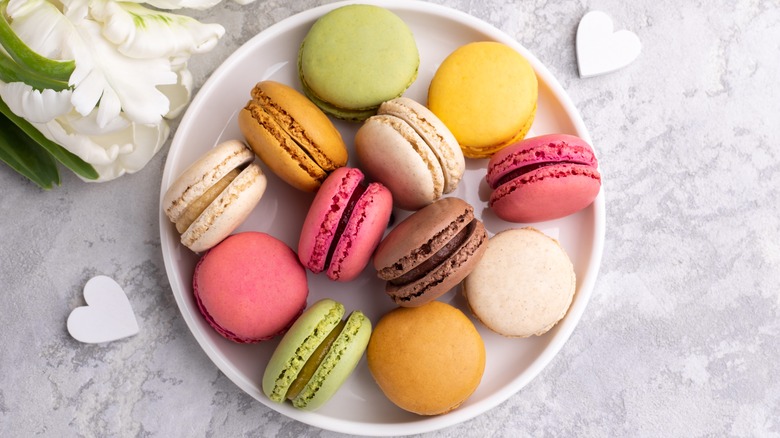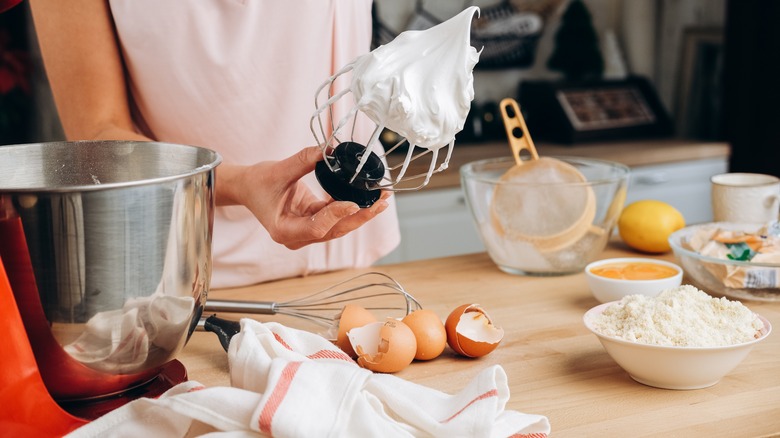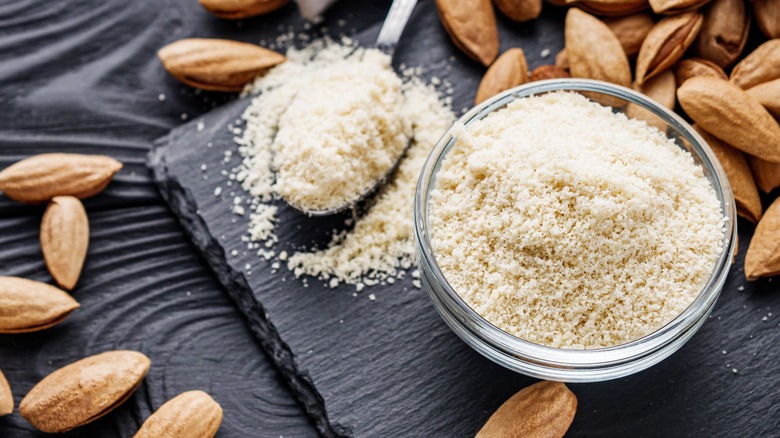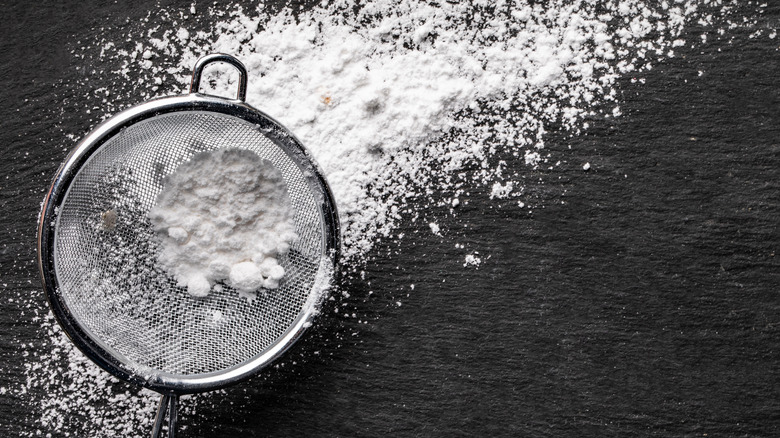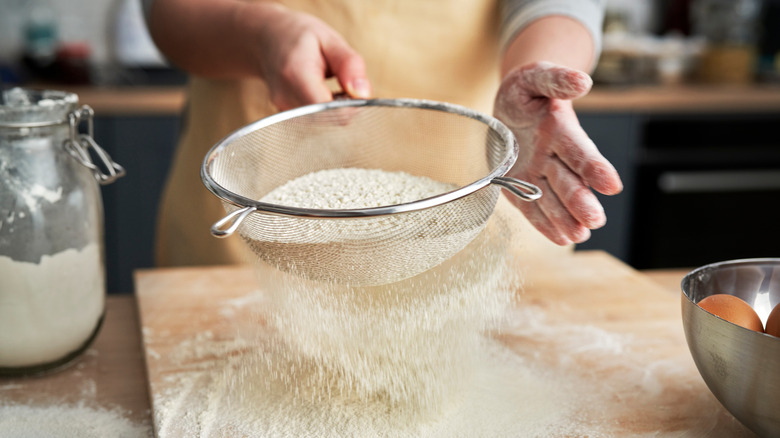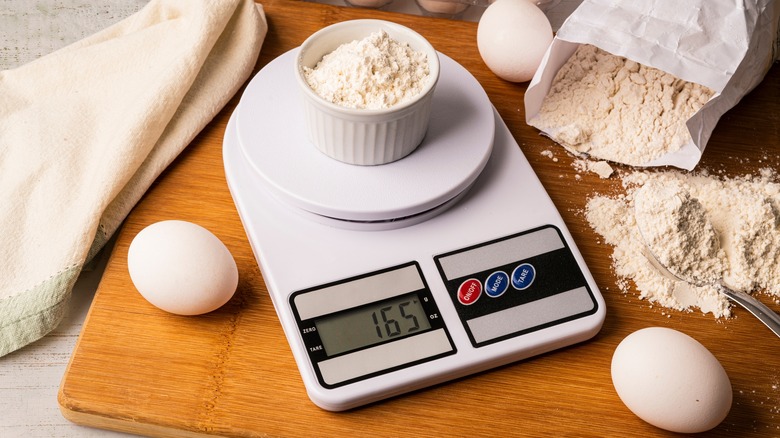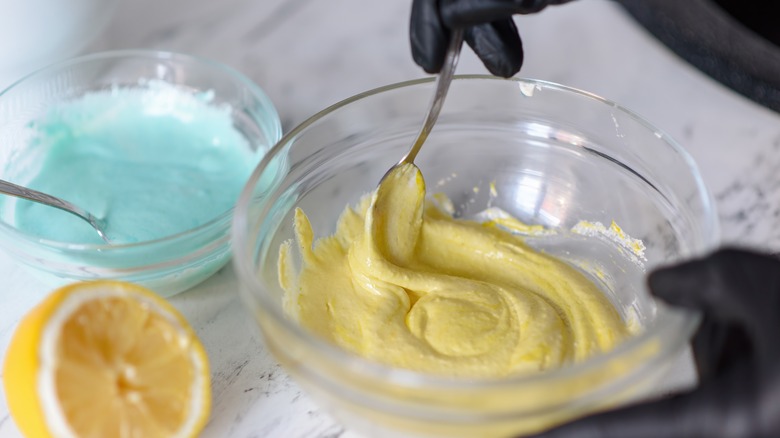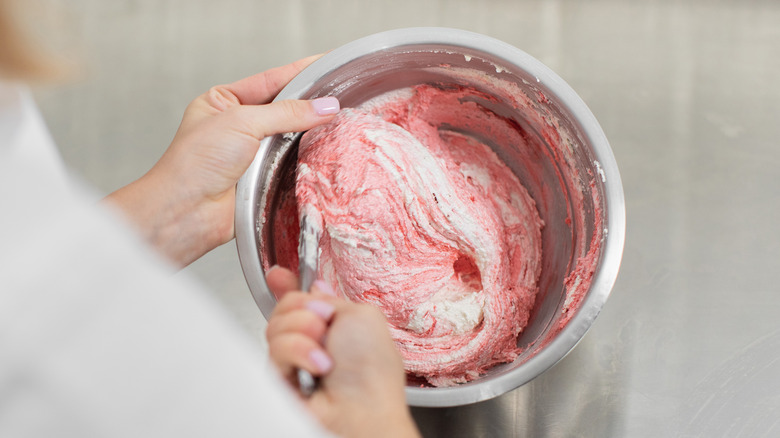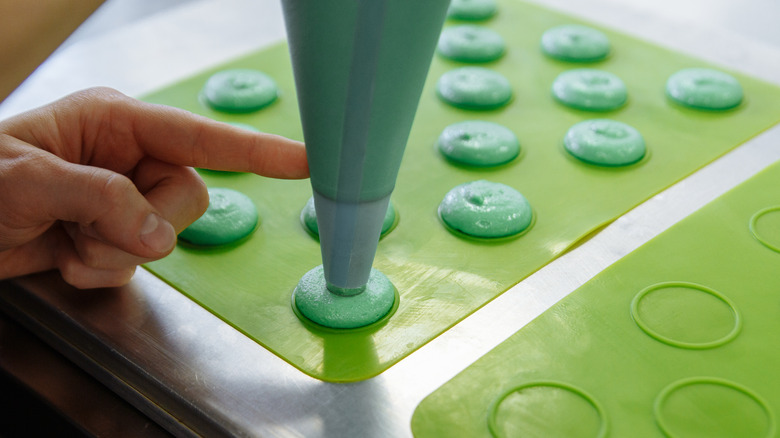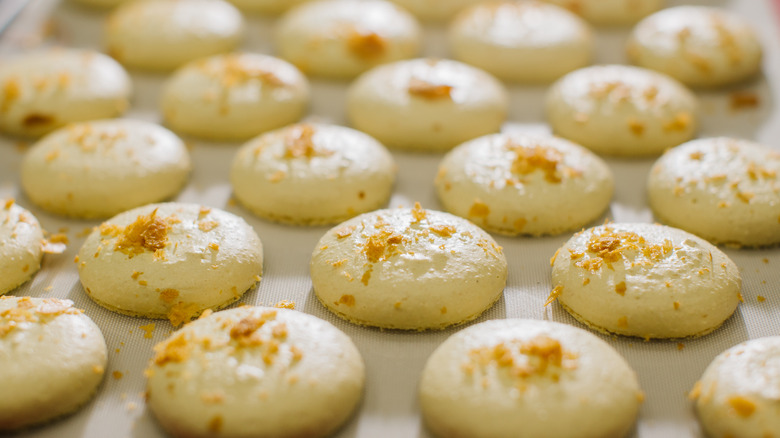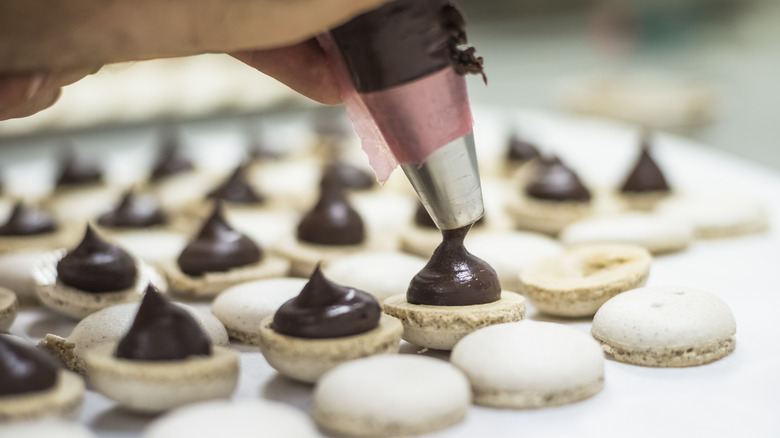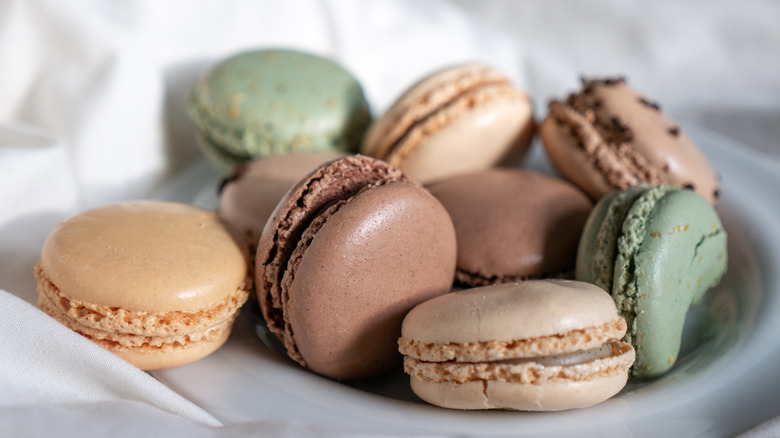Mistakes Everyone Makes When Baking Macarons
If there were a competition for the world's prettiest cookie, macarons would surely take the first prize. These elegant sandwich cookies are small, plump, perfectly round, and usually come in various bright colors and different flavors. Though they are mostly thought of as a French treat, they originate from Italy, but their popularity extends well beyond the borders of these countries. The reasons for their widespread appeal can be attributed to their charming appearance, but macarons are also incredibly delicious and their delicate, almost fragile texture makes them unique in the world of desserts where cookies usually fall into chewy or crunchy categories. Macarons are neither — their tender, melt-in-your-mouth texture paired with a creamy center makes for an exquisite treat that has no match in the dessert world.
Macarons also fall in the category of one of the trickiest desserts for home bakers. Though the list of ingredients includes only a few familiar components — the cookies are made with a simple mix of whipped egg whites, sugar, and almond flour — and the process does not seem overly complicated and complex, the batter is so delicate that even the most simple error can lead to a complete cooking disaster.
If you are determined that your next macaron attempt will be triumphant, this roundup of the most common mistakes people make when baking macarons is a great way to start. Read carefully to avoid the classic perils and become a macaron expert.
Not following the recipe to the letter
We often regard cooking as a creative process that doesn't call for a rigorous framework — where recipes are mere guiding lines that don't have to be followed to the letter. If you're a cooking novice it is generally not recommended to diverge from the recipe, but adding or removing ingredients is not frowned upon as it allows us to tweak the dishes so they would better fit our preference or taste.
Baking, however, is a different ball game and it is notorious for its stick-to-the-recipe requirement. Even the slightest change from the original can lead to a disaster. This is because baking is a chemical process where the ingredients are combined to create something entirely new. If the proportions are off-scale, the result will be inadequate. Macarons are the best example of this. The recipe calls for just a few ingredients and very specific, technically precise methods that have to be dutifully followed. On the contrary, the chemical process will fail to take place, and you will not get that nice macaron cookie that was promised in the recipe.
And be careful which macaron recipe you choose. It is best to find a reliable source with a tried and tested formula for such a technically demanding dessert. Baking macarons is not the best time to try to discover your new favorite aspiring food blogger. It would perhaps be best to find some of the original recipes published by legendary French bakeries.
Using coarse almond meal
Ground almonds, sugar, and egg whites make the base of every macaron. This list may seem overly simple, but when properly combined, these three components make baking magic happen. Each element has a particular purpose, and switching ingredients or changing the ratio when baking macarons is not recommended. Unfortunately, what many people do, perhaps unintentionally, is replace almond flour with almond meal, which is one of the biggest mistakes you can make when baking macarons.
Essentially, almond flour and almond meal are very distinct ingredients, though they are both made with ground almonds.There is sometimes a difference in labeling, but almond meal is usually made with unpeeled almonds, so it typically has a creamy, off-white color with tiny brown specks and a coarse, slightly gritty texture. On the other hand, almond flour is typically made with blanched, peeled almonds. It has uniform white color and a fine, delicate texture. Though you can often use them interchangeably, almond meal is not recommended for macarons. Almonds give macaron cookies texture and flavor. In the taste department, almond meal can make a decent substitute and provide that marzipan-like flavor, but it can cause many problems with the texture. The batter for macarons has to be smooth and homogenous, and the coarsely ground meal will probably not be able to deliver that consistency. To avoid accidents, always use almond flour; if you don't have any on hand, try to make your own by processing blanched almonds and powdered sugar.
Not using different types of sugar
If you ever embark on a quest for the best macaron recipe, you will see that most of them recommend using two types of sugar added in two separate phases. To get consistent results with your macarons, you should always follow this advice and avoid making the classic mistake of thinking that all sugar is equal. When it comes to macarons, any such assumption can lead to failure.
Classic macaron recipes, such as this Foolproof Salted Caramel Macaron recipe will recommend using granulated sugar when whipping your egg whites. These small, uniform crystals melt quickly when heated or whisked to help create a more stable, stiff meringue by protecting all those air pockets that form.
While you want to reserve that powdered sugar for the egg whites, you also need some powdered sugar in your dry almond mix. Compared to regular ground sugar, powdered sugar has a finer texture with smaller and more uniform granules. It will slightly dry out the mix which helps create that thin crackly crust on top and allow the cookie to form the so-called macaron feet — the ruffled texture that forms around the edge of each macaron cookie base as it is baked.
Not sifting the dry mix
Sifting the dry mix is another step that would be a mistake to skip as it ensures that your batter will be smooth, consistent, and provide the desired result. The dry mix for the macarons will typically include almond flour and powdered sugar, and on some occasions, cream of tartar as an additional ingredient that gives your meringue stability. There are two ways you can sift the dry mix: by mixing the ingredients first and then sifting them together or by sifting each element individually. Though sifting will allow your components to blend, give them an additional swirl afterward to ensure they are evenly distributed.
In some recipes, sifting can be omitted without any significant effect on the baked product. But for macarons, it is highly recommended to always sift the dry mix because this simple step can have a considerable influence on the texture of the cookie. Sifting will ensure that any lumps that can disrupt your batter will break, and you get a consistent mixture that will nicely blend with the meringue and give the macarons that feather-light quality.
The recipes will typically state whether the ingredients should be sifted before or after you measure them. Though it seems like a minor detail, the methods deliver slightly different measurements, so follow the recipe and sift your ingredients according to the instructions.
Measuring ingredients instead of weighing them
As macaron cookies are so tricky to make, it is paramount to be as precise as possible so measuring your ingredients in cups simply will not work here. We can all agree that cups and spoons are very convenient measuring tools in the kitchen — nothing is easier than scooping a cup of flour and dumping it directly into the cake mix. But this measuring technique has many flaws and is not precise enough when baking macarons.
Though many desserts can rely on measuring in cups and spoons, a kitchen scale is generally the better option. Essentially, cups and spoons are approximate — especially with liquid when you sometimes have to eyeball the amount. For dry ingredients, there's always the question of whether you should level off the top, or whether you should press the them tightly or pack loosely inside the cup. These concerns may seem minor, but the differences in the measured amount can sometimes be staggering, making cups and spoons a pretty unreliable option in baking.
When baking macarons, or any dessert that calls for absolute precision, use a digital kitchen scale and follow the recipe with precise measurements. This is the only way to achieve absolute consistency and always get a perfectly baked batch of macaron cookies.
Not aerating egg whites enough
Whipping egg whites and sugar makes meringue — that firm and silky cream packed with air bubbles that can easily hold its shape. You can incorporate it into sponges and creams or bake it as is. Meringue gives desserts a featherlight structure that is firm but breaks easily and has a remarkable melt-in-your-mouth quality. Together with almonds, whipped egg whites make the base of every macaron cookie. So one of the biggest mistakes you can make when baking macarons is not aerating the egg whites enough.
Macaron recipes will generally state to whip the egg whites until forming stiff peaks. The trick is to not stop mixing immediately after the eggs attain a semi-firm structure. This is one of the most common stumbling points, as people want to speed up the process and tend to stop whipping before the meringue has built enough structure. As a result, you will end up with a runny batter and flat, unattractive cookies.
Most macaron recipes will call for a French meringue in which sugar is gradually added as you whip the egg whites. This is the least fussy technique that can deliver reliable and consistent results, but if you want to build in even more strength and stability, you can test the Swiss meringue method in which sugar and eggs are whisked using a double boiler, or the Italian technique where sugar syrup is gradually added as you whip the eggs.
Using liquid coloring
You shouldn't feel pressured to add colors to your macarons, as these cookies are equally charming if left plain. However, it is true that transforming them using a kaleidoscope of pastel and vibrant colors has become a distinctive feature and somewhat of a macaron trademark. This flamboyance visually separates macarons from other French pastries that are generally subtle and rarely use additional or artificial pigments. Color can also be a very convenient method to indicate the flavor of the macaron, and you can usually know what to expect just by glancing at the cookie.
If you decide to give your macarons a coloring boost, make sure to avoid the mistake of adding liquid colors, especially if the recipe calls for different coloring agents, such as powdered or gel colors. Adding a touch of additional liquid to your macaron batter can seriously disrupt the ratio and mess up the structure. The batter will end up on the runny side, and you might not be able to shape stable, uniform macaron discs. Consequently, during baking, they won't attain that plumpness in the crust, and you will get thin, pancake-like cookies not worthy of bearing the macaron label.
Overmixing the batter
Once your dry and wet elements are set and ready to go, it's time to blend everything in the final macaron batter. If you think this is the foolproof step where nothing can go wrong, we're here to warn you that there is a strong possibility of over mixing the batter, which is a common mistake even for the most experienced pastry enthusiasts.
The process of mixing egg whites with dry ingredients is known as macronage. It involves adding the dry mix — in this case, powdered sugar and almond flour — to whipped egg whites, usually in several stages. The batter should then be blended until it becomes shiny and attains thick and smooth consistency that effortlessly flows in a gentle, ribbon-like motion. If you keep mixing after this stage, you will break the consistency and get a sloppy batter that results in flat, cracked macarons.
Technically, macronage can be done mechanically, meaning that you can whip up the batter with a hand or stand mixer. But the method is generally not recommended as it is too fast and unreliable. Mixing the batter by hand allows you to easily control the process and stop when you achieve the right consistency. You can quickly overbeat the mixture using a mixer and ruin the entire batch in seconds. While relying on modern equipment here may seem attractive, the best thing is to opt for the classic, old-school method for the most ideal results.
Not investing in proper baking equipment
Using professional baking equipment is no guarantee that you will be a successful baker. However, it does make things much easier, especially when baking technically demanding desserts, such as macarons. If you're aiming for the perfect macaron cookie, you should invest in good quality gear to make the process much easier and more enjoyable.
One of the biggest mistakes people make when baking macarons is not using an oven thermometer. This neat gadget is convenient, relatively affordable, and far more reliable than your built-in oven thermometer which can often be off (and the worst thing is that you won't even realize it). This might not be an issue with roast beef or slow-cooked pork, but when it comes to macarons, you want to be as precise as possible. The wrong temperature can cause serious problems. If it's too low, the shells will not bake properly, and you won't get that nice firm crack on the top, and if it's too high there is a danger that the shells will overbake, becoming tough and brittle.
Another possible error is to rely on parchment paper as the ideal surface for baking macarons. A silicon mat is a much better option because you can easily control the size of the cookie, and the batter won't spread as fast as it would on paper. You can also be sure that the cookies will easily slide off the mat.
Not letting the piped macaron shells rest before baking
The easiest but most commonly overlooked step when baking macarons is not letting the shells sit before putting them in the oven. All the stages before baking are relatively complicated, calling for detailed instructions and extensive research regarding the ideal ingredients or the correct implementation of the best technique. This step doesn't call for any of these — just pipe your macaron batter on the mat and let the round shells sit and relax, ideally for half an hour, before putting them in the oven.
Perhaps you're thinking that leaving the macaron batter in the open will dry it out, and you'd be right, but this will only make your macarons better. As the batter slowly dries, the top of each shell with attain a thin, firm layer. In the oven, this partially dry coating will additionally firm up to create that thin barrier that cracks when you bite into it — revealing the soft, almost sticky center of the cookie. It will also prevent the tiny air pockets from ruining the smooth surface of the cookie. Instead, they will escape from the bottom of the shells and create those infamous macaron feet.
Overfilling the macarons
Bigger is not always better, at least when it comes to macarons. These elegant French cookies are not overly large and you should be able to finish them in just a few bites. The amount of filling should also be moderate and in line with the size of the macaron. Ideally, go for a 2-to-1 ratio of cooking to filling. Macaron shells are delicate, light, and easy to break into, and you don't need an absurd amount of filling that overwhelms and smothers the nutty, marzipan-like flavor of the cookie.
While you're at it, don't be too enthusiastic and squish the macarons to push all the filling out. Lightly press the cookies until they stick and the filling is evenly distributed. All the filling needs to remain neatly packed inside the cookie. This elegant, miniature dessert should not have the creamy center oozing out and creating a mess in the baking process.
Regarding flavor combinations, macarons are a great playing ground. Fruit jams, ganache, chocolate spreads, and infused pastry creams all make splendid macaron fillings, but make sure to use flavors that go well together. Avoid using tart lemon curd for the filling if you're going for a cocoa-flavored cookie, and don't pair a rich and gooey caramel filling with a light, fruit-flavored macaron. Rely on complementary flavors and modest amounts to successfully replicate that perfect Parisian macaron.
Eating freshly baked macarons
It's hard to resist the urge to immediately dig in to a freshly baked batch of macarons you worked so hard to get right. But trust us on this one. Macarons are one of the desserts that you shouldn't eat fresh. This mistake is quite common, and we can certainly understand why, but for the ultimate macaron experience, leave the assembled cookies to rest for at least a day.The resting period will transform slightly dry cookies with delicate flavor into that perfect macaron you were aiming for at the beginning of the process.
Just like most baked goods, macaron cookies need some time to settle. When you pull them out of the oven, the heat will continue to do its magic, and only when the cookies are completely cooled will the texture begin to loosen. The smooth, crisp top will remain intact and might even firm up, but the center of the macaron will become sticky and slightly pasty. The filling will soften the cookie, and what you will get is the perfect balance of crunchy, gooey, and creamy textures. Of course, if you leave the macarons to settle down, the flavors will be able to blend better and become more prominent. However hard it might be, you will eventually get a better cookie if you just give it some time.
